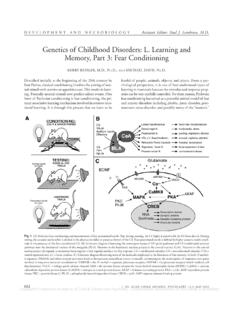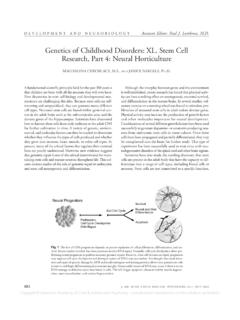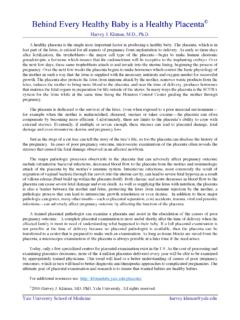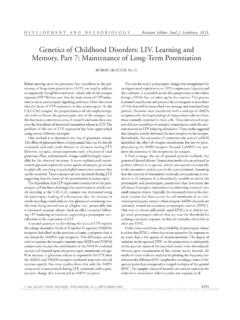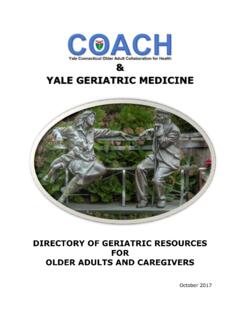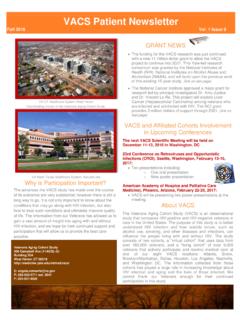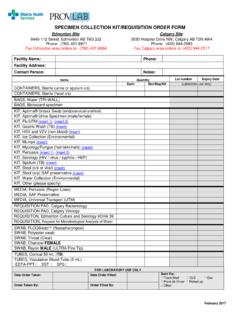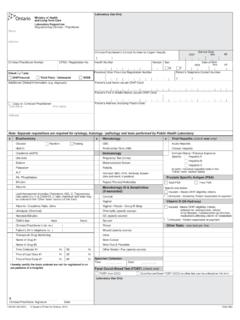Transcription of Your Coronavirus Test is Positive. Maybe It Shouldn’t Be.
1 Your Coronavirus Test is Positive. Maybe It Shouldn't Be. Published in New York Times, August 29, 2020. Discussion from a hospital laboratory perspective by Marie L. Landry, Director, Clinical Virology Laboratory, Yale New Haven Hospital Points raised in NY Times article Standard tests diagnose large numbers of people carrying insignificant amounts of virus. Most are not likely to be contagious. If Ct >33, virus not grown in culture. A cycle threshold >35 is too sensitive. A more reasonable cutoff is Ct 30-35 or even Ct <30. In NY state lab, 50% of recent positives had Ct >35. In MA, 85-90% of positives in July had Ct >30. Cycle threshold is never included in the results sent to clinicians. For outbreak tracing, cheap and abundant rapid tests are needed, even if less sensitive The basics of Ct values Correlation with amount of virus in sample What is a cycle threshold (Ct) value?
2 The cycle of amplification that the fluorescence crosses the threshold to positive. The Ct value correlates with viral load. A lower Ct value indicates a higher viral load in the sample, and vice versa. PCR commonly uses 40 cycles of amplification, and each cycle doubles the target DNA. cycles = a 10-fold change In Real-time PCR, a fluorescence signal emitted during amplification can be seen in real time , and can provide Ct values. How consistent are Ct values? Ct values vary 3-12 cycles within and between viral gene targets, PCR tests and Labs. Rhoads D, Peaper DR, She RC, et al. College of American Pathologists (CAP) Microbiology Committee Perspective: Caution must be used in interpreting the Cycle Threshold (Ct) value [published online ahead of print, 2020 Aug 12].
3 Clin Infect Dis. 2020;ciaa1199. Note: Similar variations can be seen with quantitative viral loads in copies/ml. What are the Ct value cutoffs for the 6 SARS CoV-2 tests offered at YNHH? Test Method Cycle Lab can SARS CoV-2 Gene threshold access in targets cutoffs EPIC Beaker CDC- lab developed Real-time RT-PCR <40 Yes N1, N2. Simplexa (Diasorin) Real-time RT-PCR <40 No ORF1ab, S. BD Max (Becton Dickinson) Real-time RT-PCR <40 No N1, N2. GeneXpert (Cepheid) Real-time RT-PCR <45 Yes N2, E. TaqPath (Thermofisher) Real-time RT-PCR <37 Soon ORF1ab, N, S. Panther TMA (Hologic) Transcription mediated N/A No Two regions amplification ORF1ab GeneXpert and TaqPath are the most commonly used platforms with Ct values available for review. Lab developed CDC assay is the gold standard, but uses 3 singleplex PCRs and has limited use at present.
4 What is the distribution of Ct values at YNHH? Should we report not report results of Ct >30 or Ct >35? Onset of Pandemic: Ct value distribution 3/13-4/4 for admitted symptomatic patients CDC assay used 1,016 positive (2 genes) or inconclusive (1 gene). ~14% had Ct > 30. All were acute infections requiring hospitalization Obtaining the most sensitive result was deemed essential Graph courtesy D. Peaper Case example: Diagnosis of acute infection 43 year old, with fever, cough, SOB for 8 days. Presented to ED at outside hospital. CXR showed ground glass opacities SARS CoV-2 RT-PCR negative [GeneXpert]. Sent home Patient returned to 2 days later with worsening SOB and O2 sats SARS CoV-2 RT-PCR positive [CDC assay]. Ct values: N1 N2. Patients with pneumonia may have little virus in upper airway and using a sensitive assay is essential.
5 PCR of sputum or BAL preferred, but often not available. Case example 2: Low and rising viral load 66 year old with hypertension, diabetes, on dialysis, anemic, admitted with weakness, no fever, no cough or SOB. Patient improved. SARS CoV-2 RT-PCR was ordered prior to discharge to a SNF, and was inconclusive" with only 1 or 2 genes positive. Serial PCR results over 10 days shown: PCR day Ct value N1 Ct value N2. gene gene Patient remained without symptoms If less sensitive test was used, diagnosis Day 0 Negative would have been missed and patient Day 2 discharged to SNF as COVID negative Day 5 26 Day 7 Day 10 Thermofisher and Xpert RT-PCR at YNHH: Ct values obtained from 8/11-8/31/20. Thermofisher (24 h TAT). Used for outpatients 47 positives 17 ( ) Ct >30.
6 3 ( ) had Ct >35. GeneXpert (2 hr TAT). Used for admitted patients if rapid result needed 24 positives 24 (100%) Ct >30. 17 ( ) had Ct >40 Graph courtesy D. Peaper High Ct values can diagnose acute infections Test Category N Acute Prior Uncertainc (gene target) Infectiona Diagnosis Thermofisher Ct 14 8 (57%) 6. (N gene) Ct > 3 1 (33%) 2. Xpert Ct 2 2 (100%). (N2 gene) Ct > 5 2b (40%) 3. Ct > 17 0 (0%) 8 9. a, Some symptomatic or COVID-exposed patients on initial diagnosis had high Ct values, sometimes due to delays in being able to obtain testing. b, One patient in hypoxic respiratory failure and admitted from ED to ICU had Xpert Ct value = c, No symptoms, no prior diagnosis, no reported exposures. Either past infection (most likely) or false positive.
7 Proposed: Addition of Test Result Comments for positives Ct >30 to assist interpretation Low positive: This sample was positive with a Ct A low positive can be seen either very early or later in infection, with suboptimal sample collection , or with lower respiratory tract disease. Very low positive: This sample was positive with a Ct > A low positive can be seen either very early or later in infection, with suboptimal sample collection , or with lower respiratory tract disease. Borderline positive: This sample was positive with a Ct > A. borderline positive is most likely due to recent past infection, but rarely could be a very early infection, or a false positive. Conclusion: Response to NY Times article from the perspective of a hospital COVID testing laboratory Highly sensitive tests are essential for acutely ill hospitalized patients as virus titers in the upper airway may be low (Ct >30 or Ct >35).
8 However, recovering patients, now non-infectious, may also have a very low positive PCR result. For diagnostic testing in the community, delays in obtaining testing, as well as sample type and quality, can lead to higher Ct values at diagnosis. Not reporting positive results with Ct >30 would be a disservice to these patients. Reporting Ct values alone can be misleading, especially since Ct values can vary significantly between various tests and labs. However, a result comment for low positive results may be helpful. Ct values >40 may be of questionable value. It is essential to confirm actual test sensitivity, determine the goals of testing and understand the tradeoffs in various groups: asymptomatic screening, symptomatic patients, pre procedure, L&D, high risk nursing home residents.
9 Tests with rapid but somewhat less sensitive results may be acceptable in some outpatient settings, especially when frequent repeat testing is performed.
